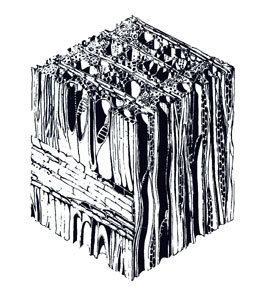摘要:由Helariutta教授兼研究总监为首的国际研究小组发现了能够控制植物根系中的木材细胞发展的遗传过程。木质部是维管组织,它能够从根部向上输送水分和养分,同时有助于茎中的木质元素的生成。这项研究报告刊登在Current Biology的杂志上,提出利用植物工程来生产更多的木材的方法。

Wood Cells
An international research group headed by Professor and Research Director Yrjö Helariutta has discovered the genetic process that controls the development of wood cells in the roots of plants. Xylem (wood cells) is the vascular tissue that transports water and nutrients upward from the root, also contributing to the formation of the woody element in the stem. The work, published in the online version of the journalCurrent Biology, presents a potential method for engineering plants to produce more wood.
All multicellular organisms start life as a single cell. This cell begins to divide, and the new cells need to take on new identities. Understanding the genetic messages that control these processes helps researchers to direct the development of plants. Plant cells can be engineered to produce more or less of a certain cell or tissue, for example. More durable and faster-growing plants are particularly important in this era of climate change and energy considerations. The goal is to direct the development of plants for practical purposes.
The research carried out by Professor Helariutta's team will help to direct future crop and forestry improvements. According to researcher Anthony Bishopp, the results enhance our understanding of how plants develop.
"The formation of water-transporting tissues has been paramount to plants' colonisation of the land. We are now presenting a mechanism through which the identity of water-conducting wood cells can be assigned," says Bishopp.
The results show that the interaction between two hormones controls the extent to which wood forms in the root. In addition to altering the movement of these hormones, the researchers altered the plants' ability to perceive them. This resulted in plants with deficient or excessive wood tissue. Wood cells are rich in cellulose, which can be harnessed to produce biofuels. The forestry industry could also benefit from trees with wood properties that have been modified to meet the needs of process technology.
The research was carried out using a small weed, the model plant Arabidopsis thaliana. The group has plans to apply the results to commercially relevant species, such as forest trees and rice.
In addition to the formation of wood tissue, the research sheds light on the development of plants in general. The development processes fascinate Bishopp:
"A fertilised egg cell contains all of the genetic information that the whole organism needs. As this organism grows, subsequent cells take on new identities and new structures appear. From a developmental biologist's perspective, it doesn't matter if this organism is a person or a plant."
The research was carried out as part of a European Research Network aimed at bringing together research institutions to stimulate economic growth, competitiveness and sustainability. The network initially included partners from Finland, Belgium and the United Kingdom but was expanded to include the Netherlands and Japan. This concerted research effort was led by Professor Helariutta (Finland). Anthony Bishopp (UK) and Hanna Help (Finland) carried out most of the work..







